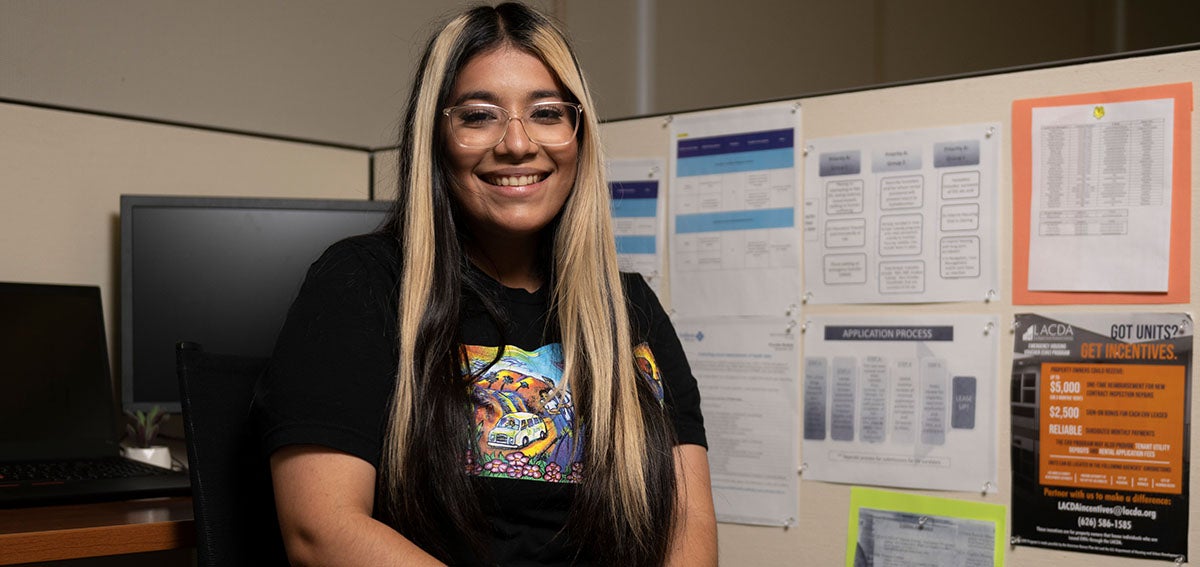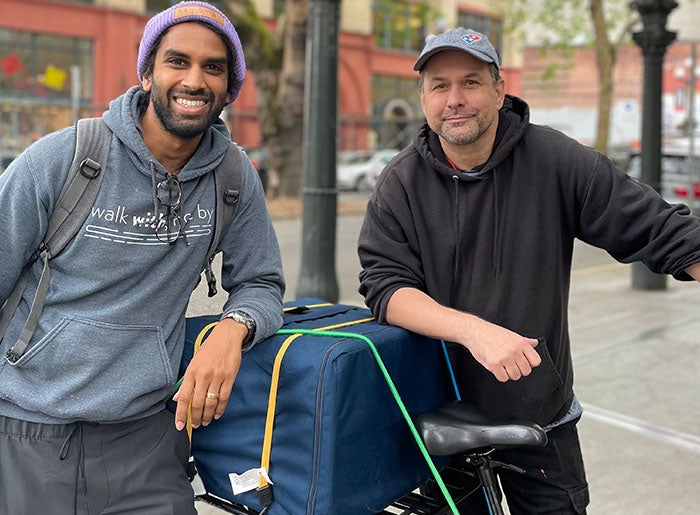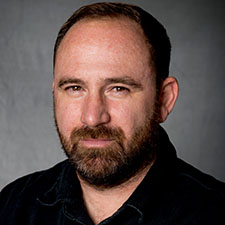
Since April, Daisy Amezcua has worked the phones from her South Los Angeles office to track down 60 unhoused people who use nearby hospital emergency rooms (ERs) as their main source of health care. They have been categorized as “high utilizers” because they visit ERs at least 6 times in a 12-month period. Some visit 30 times a year.
Amezcua, a housing care manager at St. John’s Community Health, leaves a lot of voicemails. Some of the phone numbers she tries are disconnected, others just ring and ring. Amezcua tells those who answer that they are eligible to participate in a pilot that will provide cash rewards for completing certain tasks and meeting housing- and health-related goals. Unlike other community-based outreach programs, this one leverages an online community and financial technology built by Seattle-based Samaritan, an early-stage start-up.
Samaritan’s model allows its members to create public-facing online profiles with the help of a case manager who helps them share their life stories, the challenges they face, and their personal goals. Each task, such as making an appointment to meet with a care navigator or visiting a primary care provider, yields an incentive payment of up to $20. In addition to providing cash for engagement, Samaritan offers clients the opportunity to connect with an online community of everyday people, local businesses, nonprofits, and religious organizations eager to provide financial and social support.
The services provided by Samaritan are especially timely now that the state Medi-Cal program has expanded its involvement with housing and case management services for people with complex physical or behavioral health needs. That is a key reason the California Health Care Foundation decided to invest in Samaritan.
In California, where on any given day more than 150,000 people experience homelessness, some health care organizations are turning to Samaritan and its support platform to help unhoused people to engage with case management and medical care. And it seems to be working.
“The incentives do help,” Amezcua said. “We have unhoused people who are very active on Samaritan. They have a goal they want to achieve in the next three days, and in three days those goals are met.”
An Idea Rooted in an Entrepreneur’s Struggle
Jonathan Kumar founded Samaritan in 2015, not long after he moved from Michigan to Seattle to pursue a career in start-ups. Right away he was enchanted with the Emerald City — the rain, the coffee, and the natural wonders of the Pacific Northwest.
But like many other West Coast communities, including Portland, San Francisco, Oakland, and Los Angeles, Seattle is in the grip of a major homelessness crisis. Kumar struggled to reconcile the privilege, opportunity, and beauty he enjoyed in Seattle with the pervasive human suffering he saw among unhoused people all around him, he said.
Kumar said he feels deep compassion for people experiencing homelessness, because as a child growing up in the 1980s, he experienced poverty. After his parents immigrated to the United States, they lived in public housing in Buffalo, New York, relying on food assistance programs to make ends meet. His mother worked in the home, and his father was a college student, so the family subsisted on his father’s student stipend of about $600 a month. Kumar remembers that at times the only food in the refrigerator was surplus cheese and butter distributed for free by the Reagan administration to older Americans and people with low incomes. A local church provided families with needed social, financial, and material support until they got on their feet.

“My family realized in America how important it was to have a community, a group of people that had your back,” Kumar said.
In Seattle, Kumar wanted to create the same sort of community to help the unhoused people he saw struggling each day. He handed out food and water in the city’s tent encampments, listening to people share their stories. They told him about being financially devastated by job losses, medical bills, or the challenges of managing mental health conditions or chronic illnesses. The common thread, Kumar said, was that when life went wrong, their community of friends and family was unable to help. The networks of the unhoused often consist only of others who live in poverty and are unable to support them. “I came to see that any solution for the unhoused population needed to address both the financial poverty that led to their homelessness and the relational poverty that kept them homeless,” Kumar said.
Kumar put his idea to the test, launching Samaritan, a company that licenses its support platform to health plans, providers, and government agencies.
Technology Addressing Homelessness Is Rare
CHCF’s Innovation Fund has been on the lookout for investment opportunities with start-ups that have developed innovative approaches to supporting people experiencing homelessness. This effort is especially timely as CalAIM (California Advancing and Innovating Medi-Cal), the state’s extensive revamp of Medi-Cal, focuses on housing and case management services for people with complex physical or behavioral health needs.
In preparation for the rollout of CalAIM, health systems that serve Medi-Cal enrollees with unstable housing and struggling to subsist are searching for new ways to reach that population and to keep them engaged with health services. They’re open to investing resources to test novel technological solutions.
Until Samaritan surfaced, CHCF had little luck finding a start-up with a business model that directly addressed homelessness.
“Rarely do we see technologies built for the unhoused population based on evidence-based models for patient engagement,” said Ella Schwartz, a senior program investment officer for the Innovation Fund.
When CHCF learned about Samaritan, which Schwartz describes as a health and financial technology company, it invested $200,000 to support near-term growth of safety-net partnerships in Los Angeles and Sacramento.
Schwartz compared Samaritan’s approach to contingency management, a care model that uses cash incentives to encourage people with substance use disorder to obtain treatment, and she said the clinical evidence so far shows it is effective with Medicaid populations.
“It’s a unique opportunity to learn about the value of proactively incentivizing people who are unhoused to engage in preventive care services,” she said.
Providers have limited resources, so in addition to the financial incentives, Samaritan’s software platform connects unhoused users to an online network of nearby people, businesses, and faith-based organizations that can help fill in a person’s financial or social gaps. For example, a member can ask their case manager to request help to repair a car that is broken down. A person or business with mechanical skills can volunteer to help.
Another big draw for Samaritan, Schwartz said, was that it recently partnered with a safety-net hospital and a network of community health centers in Southern California to engage with people who frequent emergency rooms, many of whom are experiencing homelessness.
Focus on Recurrent Users of Emergency Services
Samaritan has forged a promising partnership with Health Care LA, IPA, a delegated medical group made up of Federally Qualified Health Centers and community clinics, and Dignity Health’s California Hospital Medical Center, a safety-net hospital. The hospital is close to Skid Row, a downtown Los Angeles neighborhood of 50 city blocks that has been inhabited since the 1930s by thousands of people experiencing homelessness.
The two health care organizations agreed to pilot Samaritan for 200 unhoused people who rely on the emergency room as their main source of health care. The goal is to use Samaritan’s cash-incentive approach to steer them away from the ER and toward primary care, case management, and housing services.
The challenge of reducing the nonemergency use of ERs by people experiencing homelessness is exceedingly complex. Some in the hospital industry view the problem through a financial lens and acknowledge their inability to persuade people to embrace medical homes for nonemergency care instead of crowding ERs.
“The realities of living on the streets make this nearly impossible for many,” said Dalma Diaz, a CHCF Health Equity Fellow working at the intersection of health care and homelessness. “Patients have no refrigeration for medicines, no electricity for modern conveniences, no running water to clean wounds or stay hydrated, no secure place to leave their belongings when they are seeking care, and no peaceful place to rest and recuperate. They are drawn to the ER because they know they can obtain care without cost and without an appointment.”
The allure of the ER is strong for other reasons too. Hospitals are usually located on bus lines, ERs are always open, and they assess everyone. In contrast, clinics generally require appointments, may be located off the beaten track, and do not allow patients to relax on the premises for a few hours and eat a meal, experts say.
“It’s been a very challenging patient population to get our arms around,” said Sabra Matovsky, CEO of Health Care LA. Matovsky said she hopes Samaritan’s financial incentives will spark behavior change. Five clinics in Health Care LA use Samaritan and have signed up almost 80 people so far, she said.
On any given day, 5% to 10% of the patients at California Hospital consists of unhoused people, said Bob Quarfoot, the hospital’s vice president of business development.
“Our goal is very conservative,” he said. “If we can get a 10% reduction in emergency department utilization in year one, it’ll easily pay for the investment in the program.”
Get Paid to See a Doctor
Funds that a member receives or earns can be redeemed for certain items or be added to a Samaritan debit card. The funds are released under the guidance of a case manager like Daisy Amezcua, who ensures the aid is used appropriately for bills, food, rent, or clothing. One of Amezcua’s clients completed several tasks and earned enough money to pay for a hotel room for a night.
On the Samaritan app, donors referred to as “Good Samaritans” can scroll through profiles of participants and directly message or support them by paying a phone bill or buying medical supplies, groceries, clothing, or new shoes. They receive updates on users’ progress.
Cherwanna Brooks can be found on Samaritan. She wrote that she lost family support during a period when her boyfriend died, and her mother passed away.
“I never miss my doctor’s appointments, and I go to church each week to get vegetables,” Brooks wrote on Samaritan. “Still, I’m struggling to pay for food each month.” Brooks is asking the Samaritan community for grocery money and $50 to get new shoes.
Another pilot participant in Los Angeles, Felipe Hurtado, has diabetes and was asking for $200 for groceries. Hurtado shared all that with the Samaritan community.
“The frequent battles I have had with my fluctuating health have led me to face financial troubles,” Hurtado wrote, “but with determination, I wish to complete schooling and perhaps excel in mortuary science.”
Jaime López, program manager at St. John’s Community Health, said Samaritan’s support platform is a great project to incentivize patients, but its best feature is brotherhood.
“Samaritan shows them there’s a community that cares about them,” Lopez said. “It helps them feel included, and it helps them realize their goals are realistic.”
Authors & Contributors

Brian Rinker
Brian Rinker is a freelance writer and journalist. He covers digital health, public health, child welfare, start-ups, and venture capital. His work has been published by Kaiser Health News, Health Affairs, The Atlantic, Men’s Health, and San Francisco Business Times. Brian received master’s degrees in journalism and public health from UC Berkeley.

Kyusung Gong
Kyusung Gong is an independent photojournalist based in Los Angeles and the Orange County area. He is a former staff photographer at the Orange County Register. He is working on an MFA degree in photography at the Academy of Art University and is a journalism lecturer at Cal State Long Beach.



